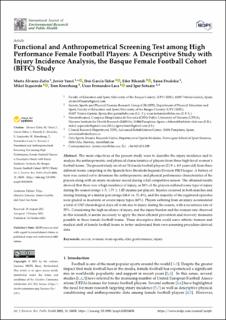| dc.contributor.author | Álvarez-Zafra, Marta | |
| dc.contributor.author | Yanci, Javier | |
| dc.contributor.author | García-Tabar, Ibai | |
| dc.contributor.author | Bikandi, Eder | |
| dc.contributor.author | Etxaleku, Saioa | |
| dc.contributor.author | Izquierdo, Mikel | |
| dc.contributor.author | Krosshaug, Tron | |
| dc.contributor.author | Fernandez-Lasa, Uxue | |
| dc.contributor.author | Setuain, Igor | |
| dc.date.accessioned | 2021-12-08T16:12:51Z | |
| dc.date.available | 2021-12-08T16:12:51Z | |
| dc.date.created | 2021-10-26T11:27:11Z | |
| dc.date.issued | 2021 | |
| dc.identifier.citation | International Journal of Environmental Research and Public Health. 2021, 18(20), Artikkel 10658. | en_US |
| dc.identifier.issn | 1661-7827 | |
| dc.identifier.uri | https://hdl.handle.net/11250/2833456 | |
| dc.description | This article is an open access article distributed under the terms and conditions of the Creative Commons Attribution (CC BY) license (https://creativecommons.org/licenses/by/4.0/). | en_US |
| dc.description.abstract | The main objectives of the present study were to describe the injury incidence and to analyze the anthropometric and physical characteristics of players from three high-level women’s football teams. The present study involved 54 female football players (21.9 ± 4.9 years old) from three different teams competing in the Spanish Reto Iberdrola-Segunda División PRO league. A battery of tests was carried out to determine the anthropometric and physical performance characteristics of the players along with an injury incidence record during a full competitive season. The obtained results showed that there was a high incidence of injury, as 38% of the players suffered some type of injury during the season (range 1–5; 1.75 ± 1.02 injuries per player). Injuries occurred in both matches and during training at a similar percentage (48.6 vs. 51.4%), and the majority of the registered episodes were graded as moderate or severe injury types (60%). Players suffering from an injury accumulated a total of 1587 chronological days off work due to injury during the season, with a recurrence rate of 55%. Considering the high incidence of injury, and the injury burden and the reinjure rate observed in this research, it seems necessary to apply the most efficient prevention and recovery measures possible in these female football teams. These descriptive data could serve athletic trainers and medical staff of female football teams to better understand their own screening procedure-derived data. | en_US |
| dc.language.iso | eng | en_US |
| dc.subject | elite | en_US |
| dc.subject | injury | en_US |
| dc.subject | performance | en_US |
| dc.subject | soccer | en_US |
| dc.subject | team sports | en_US |
| dc.subject | women | en_US |
| dc.title | Functional and anthropometrical screening test among high performance female football players: A descriptive study with injury incidence analysis, the Basque Female Football Cohort (BFFC) study | en_US |
| dc.type | Peer reviewed | en_US |
| dc.type | Journal article | en_US |
| dc.description.version | publishedVersion | en_US |
| dc.rights.holder | © 2021 by the authors | en_US |
| dc.source.pagenumber | 15 | en_US |
| dc.source.volume | 18 | en_US |
| dc.source.journal | International Journal of Environmental Research and Public Health | en_US |
| dc.source.issue | 20 | en_US |
| dc.identifier.doi | 10.3390/ijerph182010658 | |
| dc.identifier.cristin | 1948491 | |
| dc.description.localcode | Institutt for idrettsmedisinske fag / Department of Sports Medicine | en_US |
| dc.source.articlenumber | 10658 | en_US |
| cristin.ispublished | true | |
| cristin.fulltext | original | |
| cristin.qualitycode | 1 | |
